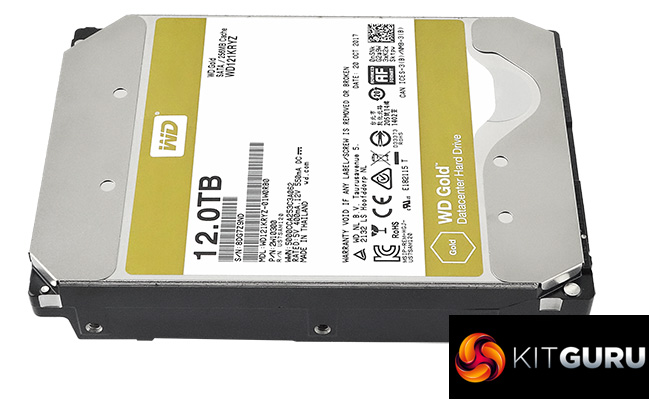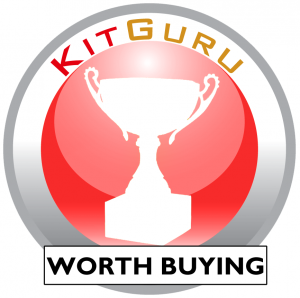The Western Digital 12TB Gold is the latest and currently largest capacity drive in WD's drive range aimed at the enterprise market where the demands for increased storage density are growing ever larger. The Gold range of drives have a number of built in technologies to help them survive 24 x 7 365 days a year in the most demanding storage situations and to this end have a 2.5m hour MTBF rating. The drive uses WD's 4th generation HelioSeal helium technology. Since its inception HelioSeal has been used in over 15 million (and counting) shipped drives.
Helium technology has allowed drive manufacturers to produce larger capacity drives thanks to its property of being 1/7th the density of air, reducing the internal turbulence and friction on the platters, actuating arms and heads. The reduction of turbulence inside the enclosure means that more platters and heads can be built in the same internal space.
Another benefit of the reduced friction is lower thermals and power consumption, so not only are these disks much larger than previous generations, they are also cheaper to run per gigabyte of storage in power consumption terms, a very important attribute in the environments they are aimed at.
To help keep the drive protected against vibration in large multi disk housings Western Digital have the drive spindle attached at the top and bottom of the drive. The drives also have enhanced RAFF technology which monitors the drive and corrects, in real time, rotational vibrations to improve drive stability.
DFH (Dynamic Fly Height) technology ensures that the fly height of each read/write head on the dual-stage head actuator's are adjusted in real time for consistent, reliable performance. TLER (Time Limited Error Recovery) comes into focus in RAID arrays and helps to reduce time lost to drive fallout due to excessively long error recovery times.
The 12TB Gold drive is power efficient and performs the neat trick of using less power through every stage of its use than the 6TB Gold model. Average power requirements for the Sequential Read/Writes is 7W and 6.8W respectively, for the 6TB model it's 9.3W and 8.9W respectively.
Random Read/Write average power for the 12TB drive is 6.9W (9.1W for the 6TB drive) with the 12TB drive using 2.1W less power when in idle mode; 5.0W than the 7.1W of the 6TB drive.
We found the 12TB WD Gold available to pre-order on Overclockers UK for £489.95 (inc VAT) HERE
Discuss on our Facebook page, over HERE.
Pros
- Overall Performance.
- Performance protecting technologies.
- 5-year warranty.
Cons.
- Its not cheap but then it is aimed at the enterprise segment.
Kitguru says: WD's Gold 12TB offers huge capacity with good overall performance with plenty of onboard technoloiges to help it survive in its intended environment.
 KitGuru KitGuru.net – Tech News | Hardware News | Hardware Reviews | IOS | Mobile | Gaming | Graphics Cards
KitGuru KitGuru.net – Tech News | Hardware News | Hardware Reviews | IOS | Mobile | Gaming | Graphics Cards






550MB a year work load.! i hope they mean TB
256GB cache ?
MB*
What about noise levels and temperatures? For home NAS usage, those are very relevant parameters when choosing HDDs.
It is never mentioned. Many people want to know, but every time they seem to “forget” that, or answer any questions about it. Definitely much more important than 240 or 260MBs throughput..
“WD claim a 550MB a year work load.” This doesn’t look right
I know – if 550MB per year, it would take you the entire lifetime to fill up the drive 😉
It IS 550TB
Real specs:
Designed with a workload rating up to 550TB per year
Up to 2.5M hours MTBF with a 5 year limited warranty
4th generation HelioSeal technology (12TB)
RAFF technology for vibration protection
RAID-specific time-limited error recovery (TLER)
Was going to buy seagate, but found these beauties at a great price so going in for 4 initially 🙂
Same spam bots on all the tech sites. I doubt “Cheryl” could earn that much in one month unless it was through illicit means.
550TB per year doesn’t sound much. That’s like 45TB per month, 11TB per week, 1,63 TB per day. How is this a high workload?
Compared to ssd drives it is a lot. Compared to seagate enterprise drives they are about the same. Barracudas are at 300TB year. I have done more than the specced workloads without any issues. Typical use even in enterprise is not that high unless you are writing TB data daily such as telecommunications companies do. This only recently appeared as part of hard drive specs. You can clearly exceed the workload but if the drive dies prematurely I bet they try to get out of warranty replacement. But having worked telecom, we constantly replaced hard drives due to heavy workloads back in the early 2000s.